Dutch Houses Park – A Tribute to Post-War Dutch Heritage in Brisbane
The Dutch Houses Park in Coopers Plains commemorates a remarkable post-war initiative that linked Dutch innovation with Australian reconstruction. In the early 1950s, a partnership between the Queensland Government and a Dutch company brought prefabricated housing, new building methods, and skilled migrants to Brisbane’s southside.
This collaborative project played a key role in shaping the local community and highlights the enduring contribution of Dutch migrants to Australian society. The naming of Dutch Houses Park in 2025 recognises this shared history and helps preserve it for future generations.
This page explores the origins, legacy, and community efforts to protect and celebrate the Dutch Houses — including personal stories, heritage campaigns, media features, and the park’s unveiling.
The Dutch Housing Project: Background
In the aftermath of World War II, Australia faced a severe housing shortage, made worse by the large influx of new migrants arriving under post-war resettlement programs. Brisbane, like many other cities, was struggling to accommodate its growing population. Skilled labour was in short supply, construction materials were limited, and the capacity of local industries was stretched thin.
To address these challenges, the Queensland Government began looking overseas for practical solutions. Among the countries that responded was the Netherlands. Drawing on their own experience with prefabricated housing and post-war reconstruction, a Dutch construction firm, J. Krap, was invited to Australia to assist with residential development.
The Dutch project was spearheaded by Willem Schumacher, an experienced Dutch contractor who had already built over 900 similar homes in the Netherlands. In 1951, Schumacher brought with him 73 skilled Dutch tradesmen and labourers, along with their families, to take part in the construction effort. They arrived with prefabrication equipment, concrete block presses, roofing tiles, window frames, doors, flooring, and even kitchen sinks—essentially an entire mobile construction supply chain.
To oversee the Australian operations, Schumacher established Concrete Buildings Pty Ltd, a local subsidiary of the Dutch parent company. The work began in earnest in the suburbs of Coopers Plains and Sunnybank, with homes constructed in areas bounded by Boundary Road, Throughton Road, and Breton Street.
Over the following three years—between 1951 and 1954—around 300 concrete homes were built using this Dutch system. Streets such as Lawford, Jamaica, and Babbidge became notable clusters of these unique dwellings. Many of the Dutch workers settled in the area themselves, forming a nucleus of Brisbane’s growing Dutch migrant community.
Technical Innovation and Challenges
The construction system was highly innovative for its time. The houses were made of concrete blocks formed on site, a method far less common in Queensland than traditional timber-framed housing. The prefabrication approach significantly sped up construction and offered a durable, fire-resistant alternative to conventional materials.
However, there were also challenges. Brisbane’s subtropical climate presented unforeseen issues for homes designed with colder, drier Dutch conditions in mind. Some houses suffered from rising damp, poor ventilation, and concrete cracking. A 1953 Courier Mail review even critiqued the homes as being too compact, lacking natural light and architectural imagination. Termite issues also arose, leading to widespread fumigation efforts in subsequent years.
Despite these setbacks, the homes were well-regarded by many residents for their solid construction and clean design. Their affordability and availability during a critical post-war period made them especially valuable for working families and new arrivals.
Social and Migrant Impact
The Dutch Housing Project was more than just a building initiative—it was a migration story. The Dutch workers were contracted under Australia’s assisted migration schemes and became permanent settlers in the country. Their families integrated into the local community, and many of their descendants still live in the area today.
The project introduced new ideas, tools, and work practices to the Australian construction sector. It also helped shape a distinct Dutch-Australian identity in Brisbane, one that remains visible through surviving homes, street names, and stories passed down through generations.
Interestingly, the project took place just a short distance from Camp Columbia, which during the war had hosted the Netherlands East Indies Government-in-Exile. This geographic continuity—from wartime alliance to post-war resettlement—adds an important historical layer to the Dutch presence in Brisbane.
Decline and Redevelopment
By the 2000s, many of the Dutch Houses had deteriorated or were seen as out of step with modern urban development plans. Several were demolished to make way for high-density apartments and townhouses, particularly in the redevelopment zone known as Cornerstone Living. Others were sold into private hands and gradually renovated, often retaining key original features.
Today, some 50-60 of the original homes remain. Some are still occupied, while others are vacant and at risk of demolition. Local historians, heritage advocates, and Dutch community groups have fought to preserve this legacy, resulting in renewed attention to their architectural and cultural value.
The official naming of Dutch Houses Park in 2025 and the 2024 heritage listing nomination of six surviving homes are important steps in ensuring that this overlooked chapter of Queensland’s post-war story is not forgotten.
Historic Photos
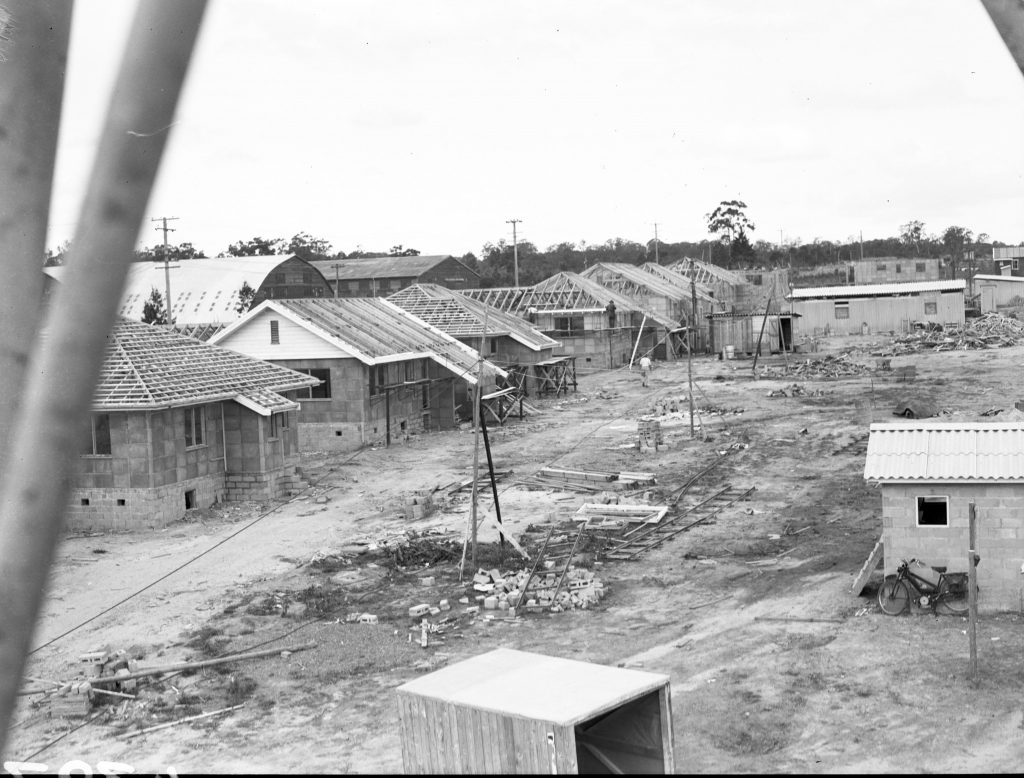
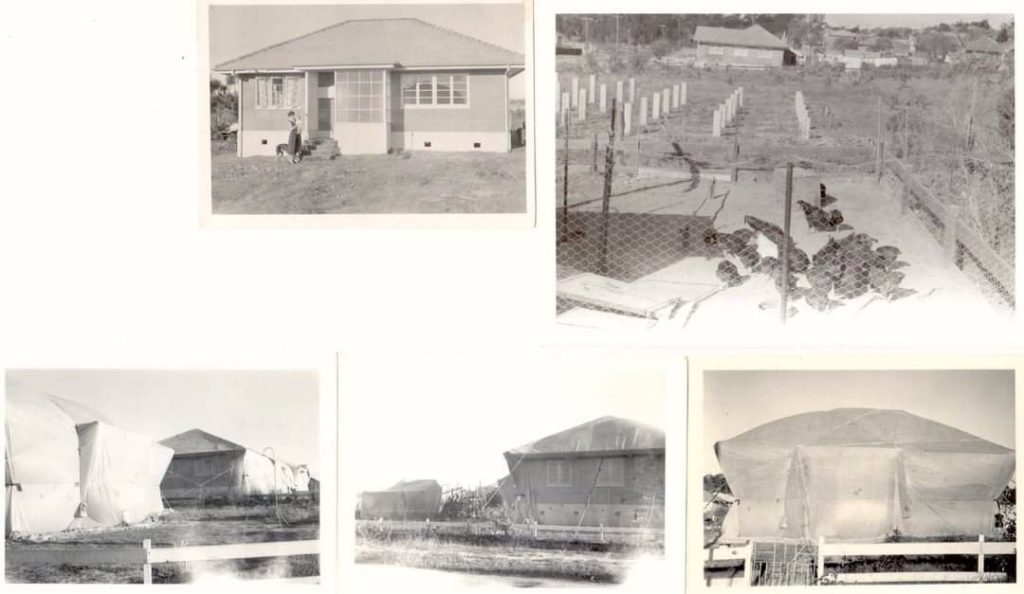
Photos Brenda Koster family collection.
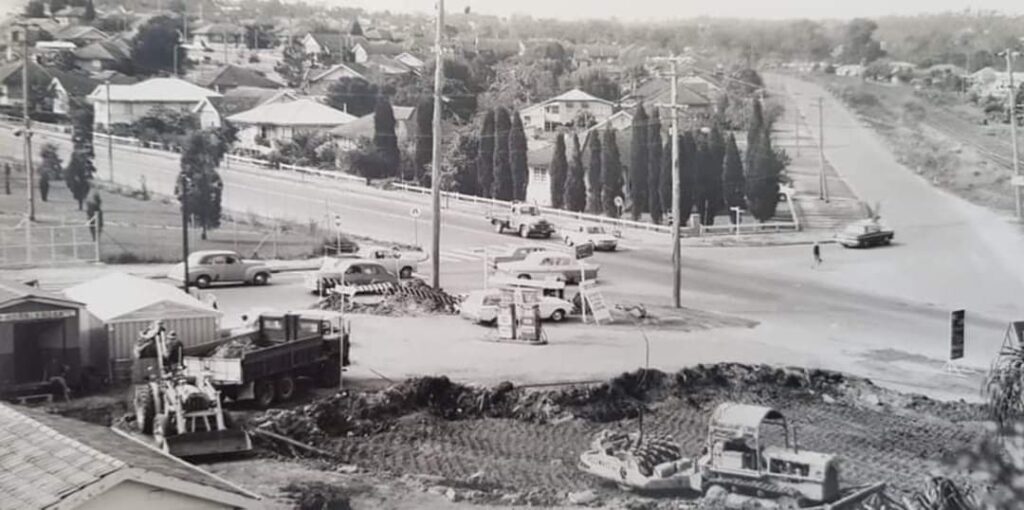
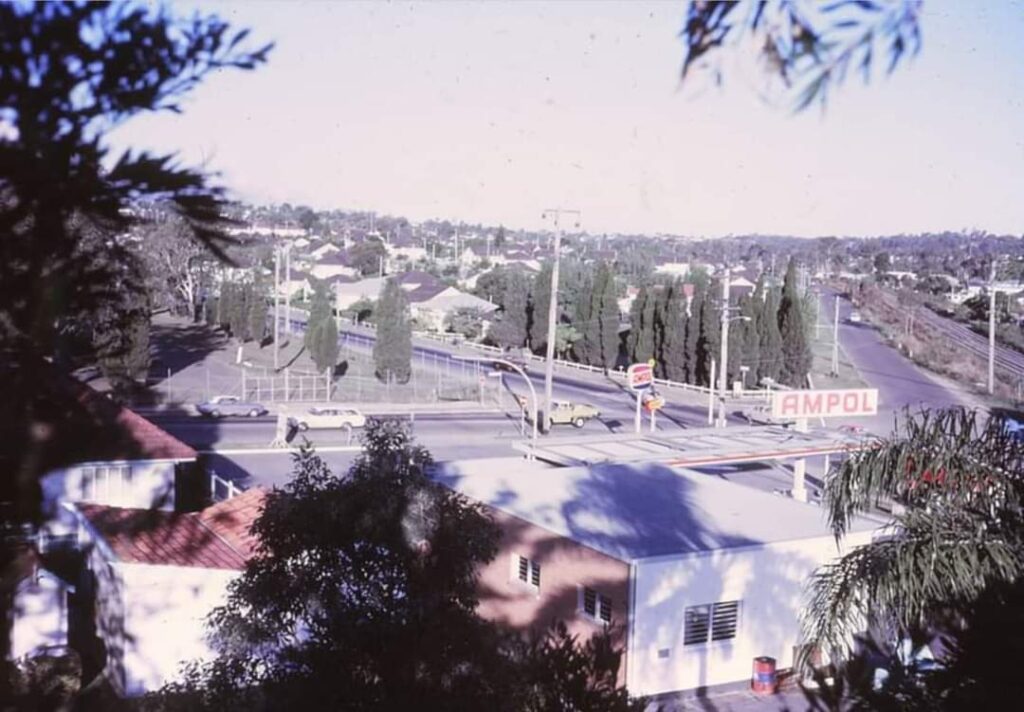
Looking out towards the Dutch houses. The old Ampol garage in the foreground had just been demolished to make way for the newer building (late ’60s – early ’70s)
Personal Stories and Community Voices
The Dutch Houses are deeply embedded in community memory. Several families contributed stories and photographs documenting life in the homes and the migration journey that brought them there.
Notable accounts include:
- The Schouten family (Ted and Jack/Jaap), who arrived from the Netherlands in 1951 under contract to build the houses
- The van de Elzen family, whose son Louis was born in 1952 in one of the homes
- Fred and Marijke van Breemen, long-time residents and heritage advocates (SBS interview above)
- Public contributions:
- “I grew up in a Dutch house in Macdevitt Street. My grandma lived there over 40 years.” – Kristy
- “My mother sold her Dutch house on Boundary Road in 2017. I loved our Dutch house.” – Kerry
Visitors are invited to share their own stories through the Coopers Plains History Group.
The company and their families arriving in Australia
The following articles and pictures provide further background on the history surrounding the Dutch Houses. Followed by a report on the staff travelling from the Netherlands to Australia.
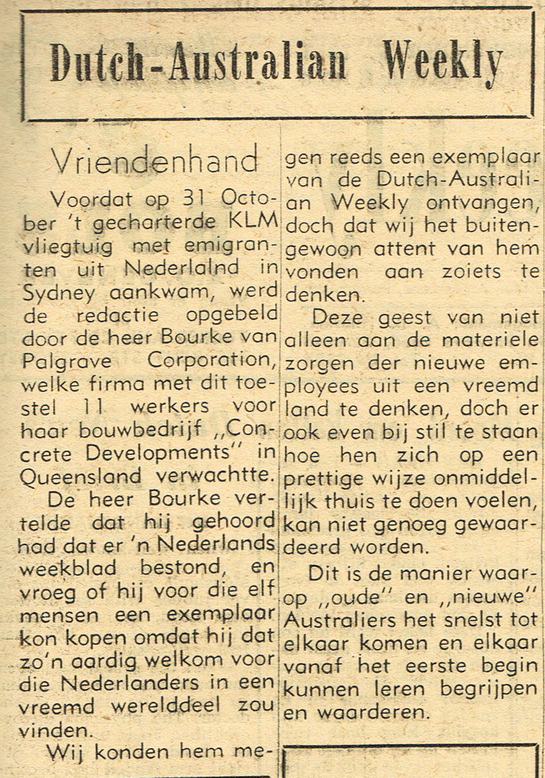
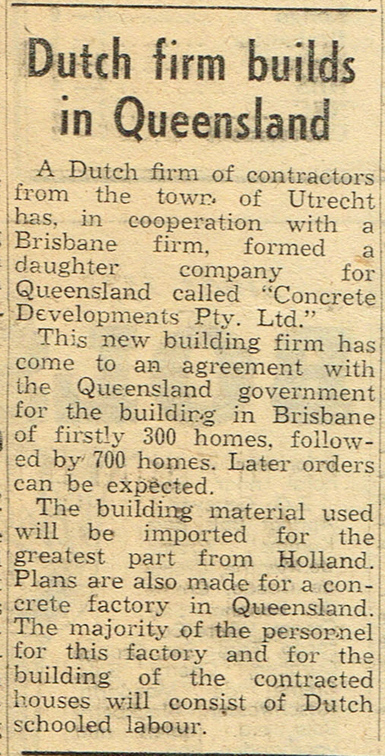
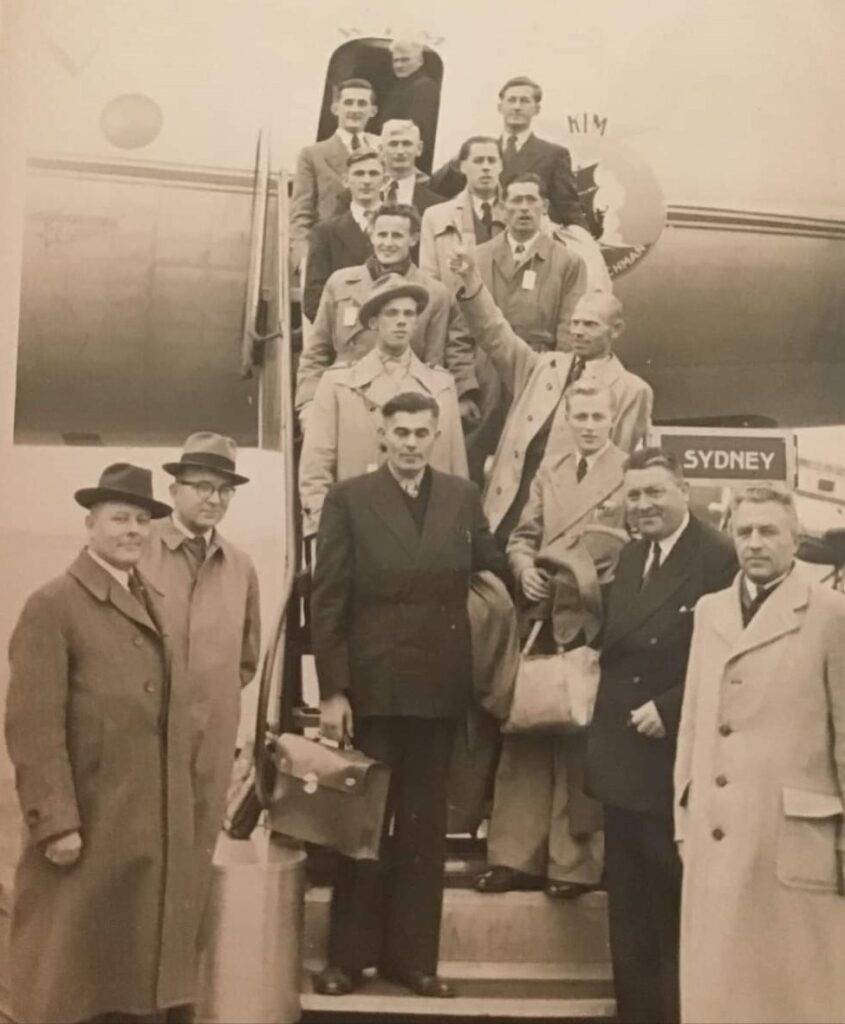
Back to work again swinging the hammer. Word got around that the company we were working for had won a contract to build 300 houses for the Housing Commission in Brisbane (where is Brisbane??). Anybody interested with the view of migration, offering 40hrs work per week, instead of 44, more money, accommodation, board and better climate. Gerard and I put our names down (Jack was still in Korea, serving for the United Nations). He came back in October and put his name down. After an interview by the company and immigration official at the Australian Council in Den Haag, we got our papers, so Jack and I said good bye to Mum, Dad, Oom Hein and the family, never to see them again. Jack and I and 9 other single men left Holland by plane on 26th October 1951.
The first day the plane landed in Nicosia, Cypress, everyone out including the crew, in a bus, to a hotel, next morning back to the plane, this was repeated again in Bombay, Bangkok, and Manilla. Then we arrived in
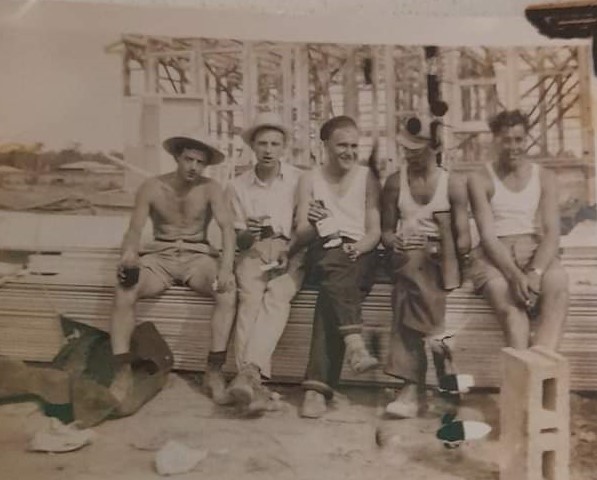
Darwin, through the customs in a shed where half of the sheets of fibro were broken or had holes in them. (This was not a good impression!) Next morning we landed in Sydney, it was the ist November, 1951. There to meet us was a company official, to put us on a plane to Brisbane. It was a Dakota DC3 and it took 3 hours to get to Brisbane. (collection: Janeen Schouten – the Family Scouten eventually moved into one of the Dutch House in Beaudesert Rd).
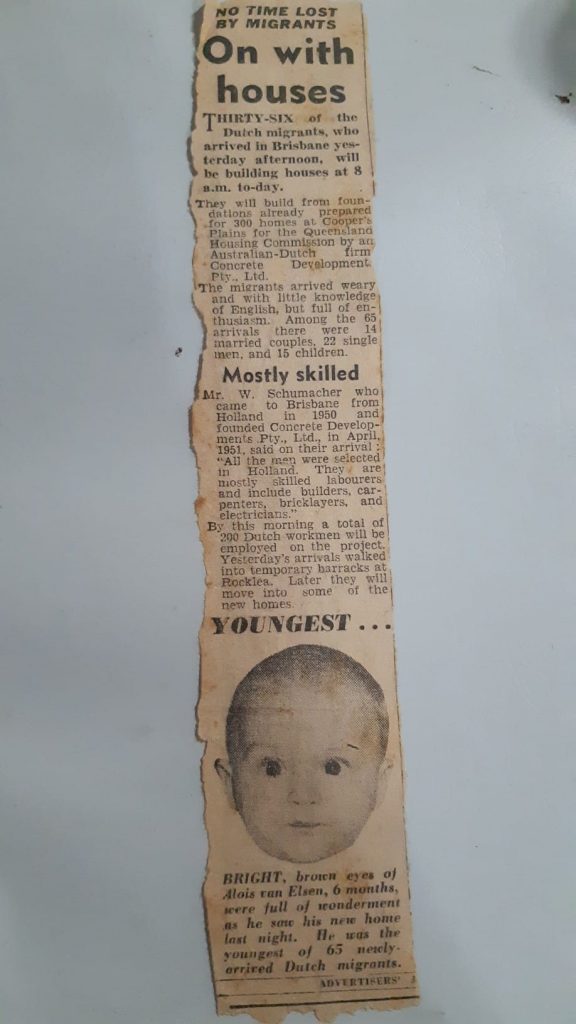
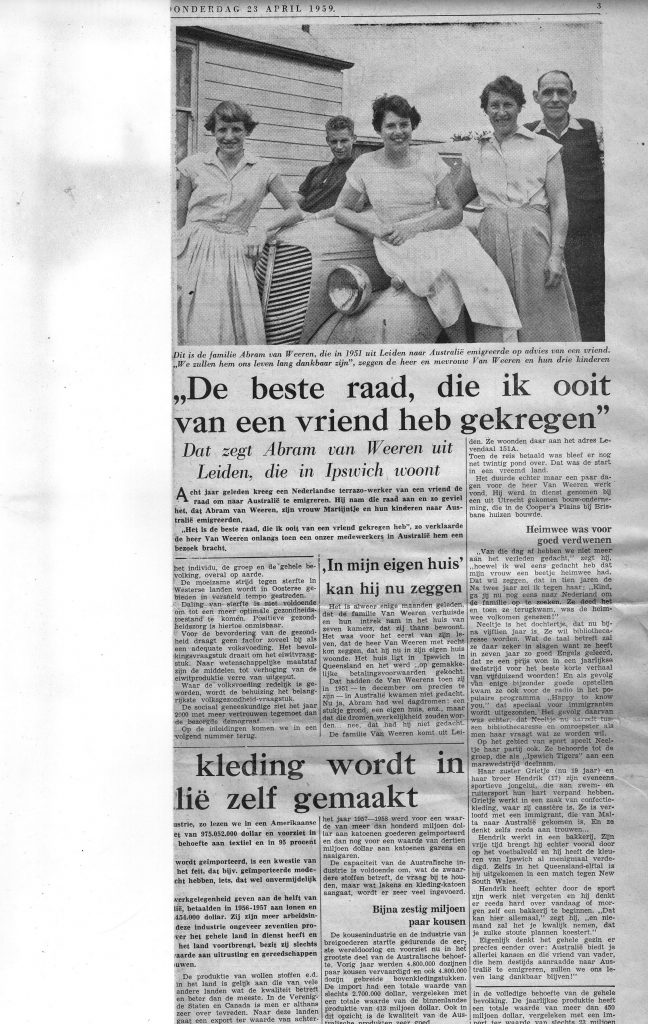
We are very interested to hear from people with personal stories. They might be from early Dutch migrants or their children. People who live or lived in these houses and from people whose families were involved in the building of these house. Your comments can be made on the Coopers Plains History Group website (see under Recent Posts in the right hand list).
Park Opening Ceremony – 29 August 2025
On Friday 29 August 2025, the park on McKoy Street, Coopers Plains—formerly McKoy Street Park—was officially renamed Dutch Houses Park. The ceremony was attended by local residents, community representatives and dignitaries, including Councillor Kim Marx (Runcorn Ward), Mrs Marjon Wind (Honorary Consul of the Kingdom of the Netherlands), Paul Budde (Chair of the Dutch Australian Cultural Centre), and Simon Cole (Chair of the Coopers Plains History Group).
The event included speeches, the unveiling of the new sign, and a cake cutting to mark the occasion. We encourage visitors to enjoy the park and read the interpretive signage that outlines its important historical context.
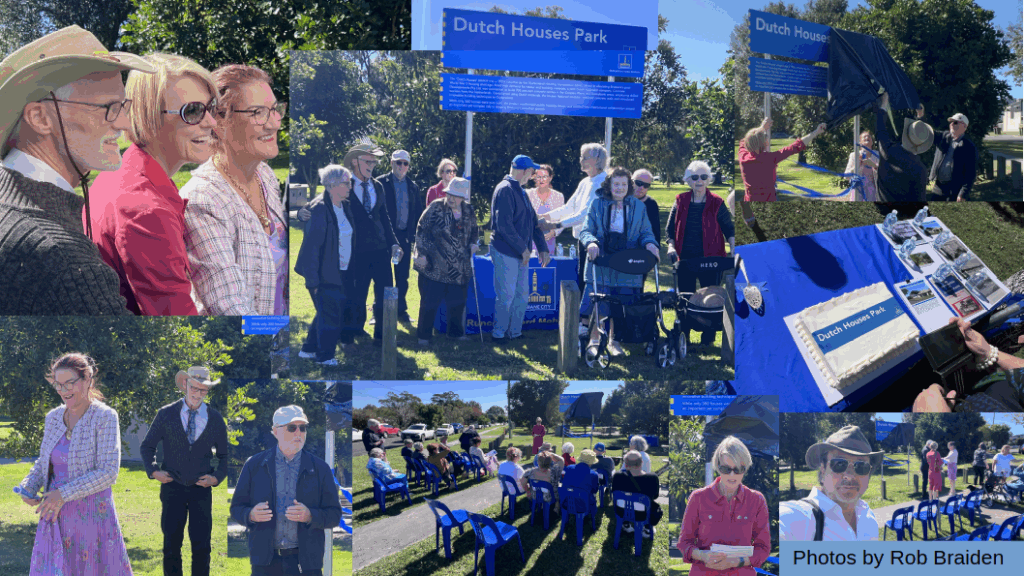
Videos produced by Robert Braiden from WalkaboutWithRob.
Heritage Listing
In May 2024, six well-preserved Dutch Houses in Sunnybank were nominated for inclusion in Brisbane City Council’s Local Heritage Register—a campaign championed by the local community, the Coopers Plains History Group, and the Dutch Australian Cultural Centre (DACC). DACC aided this effort by providing historical research, community engagement, and contributions to the formal nomination submission. Members of both groups continue to collect oral histories from residents, many of whom trace their roots to Dutch migrant families.
In June 2025, the nomination was formally accepted and the group of six Dutch Houses was officially listed in Brisbane’s Heritage Places database, under Place ID 2816. Heritage Brisbane The listing confirms these homes as a “highly intact group of 6 Dutch Houses” built between 1951 and 1955, and recognises their significance in illustrating the post-war housing response of the Queensland Housing Commission in collaboration with Dutch contractors.
The houses now protected under this listing are located at:
- 19 Aldershot Street, Sunnybank
- 15 Lawford Street, Sunnybank
- 17 Lawford Street, Sunnybank
- 19 Lawford Street, Sunnybank
- 21 Lawford Street, Sunnybank
- 4 Pasteur Street, Sunnybank
These properties are among the best surviving examples of the Dutch Houses in Brisbane. While they remain occupied and are maintained under standard government regulations, their location in quiet residential back streets limits public visibility. However, their heritage listing ensures their stories and significance are permanently recorded and publicly accessible online.
The role of Simon Cole continues to be central to this success—his persistent advocacy, local research, and community connections have been instrumental in making this recognition possible. The heritage listing is a milestone achievement for the DACC, the Coopers Plains History Group, and the broader Dutch-Australian heritage community in Brisbane.
Media Coverage and Public Awareness
The Dutch Houses project has attracted renewed public attention through various media and community platforms.
- ABC Radio Brisbane: Interview with Simon Cole (listen from 2:44:00 to 2:55:30)
- SBS TV Clip Dutch Houses Coopers Plains : Focus on the demolition and redevelopment of Dutch Houses in Coopers Plains
- Courier-Mail article (2016): “Ghost Houses” by Joe Gorman
- YouTube Videos by Robert Braiden (WalkaboutWithRob)
- Dutch Houses history (5 January 2024)
- Netflix series Boy Swallows Universe: Filming location includes Dutch Houses in Babbidge Street
Related Publications and Exhibits
Flickr Album – Surviving Dutch Houses (2020–2021) by Paul Budde
https://www.flickr.com/photos/12951450@N00/51042640491/in/album-72157714510525302
The Dutch Houses of Coopers Plains by Alfons Vernooy
This book played a pivotal role in reviving public interest in the project. It documents the planning, construction, and legacy of the Dutch Housing Project and includes rare photographs and detailed historical accounts.
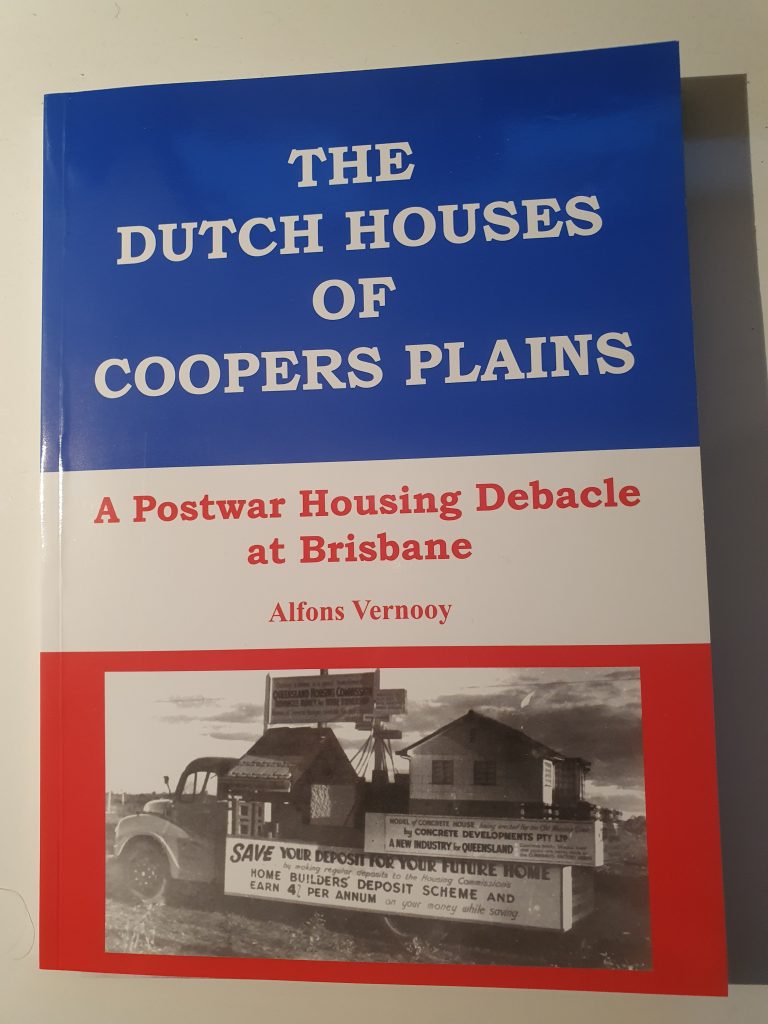
Comments from readers:
I grew up in Macdevitt St Coopers Plains in a Dutch house also my grandma lived in the same street for over 40 years. They were the best houses strong and well built. Kristy
| My mother sold her Dutch house on Boundary Road Coopers Plains 5 years ago (2017) .. she is 82 . Her parents were original tenants in the house . I loved our Dutch house . Kerry |
Other Dutch builders and architects from those times
There were other post-war Dutch architects as well.
The Dutch-Australian Architect John van den Broek designed some beautiful modest little houses in the 1950s. 8 Bernecker St Carina being one and 30 Fleetway St Morningside being another. They are each only two bedroom, and originally had landscaped gardens designed by his wife, Barbara van den Broek who also designed the Qld Cultural Centre gardens for Robin Gibson.
Photo Gallery

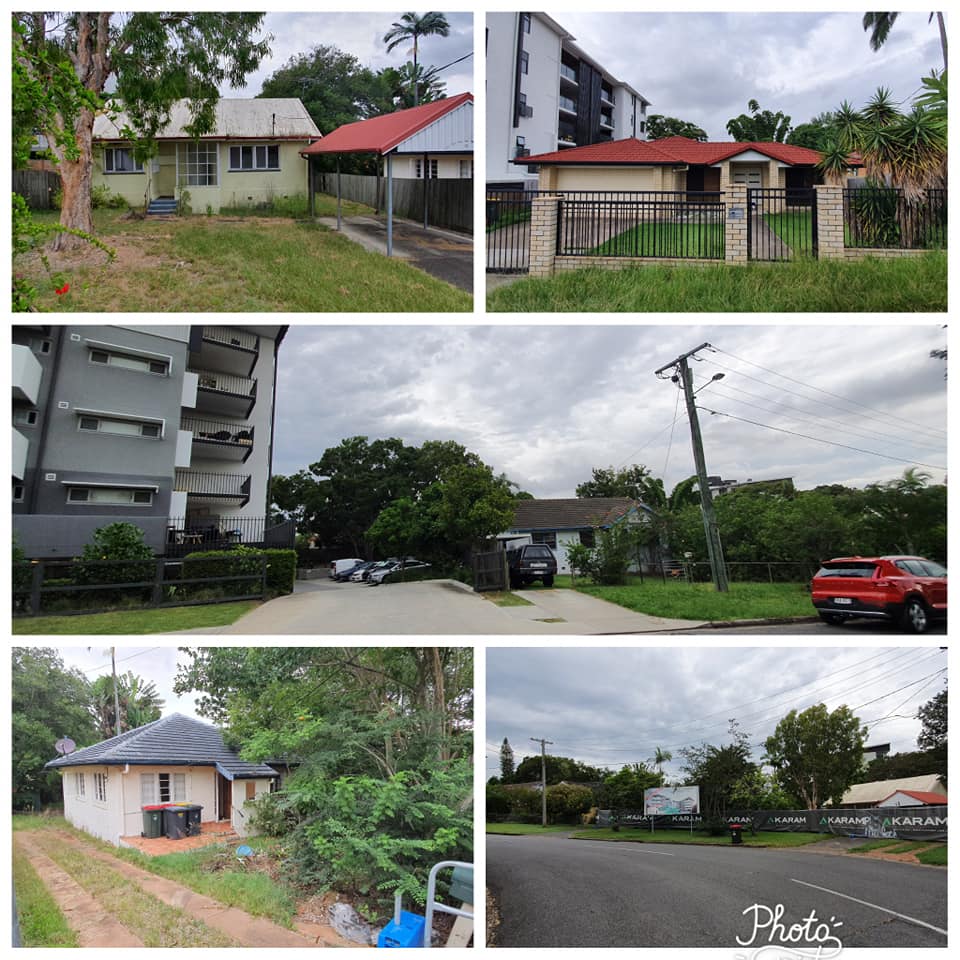
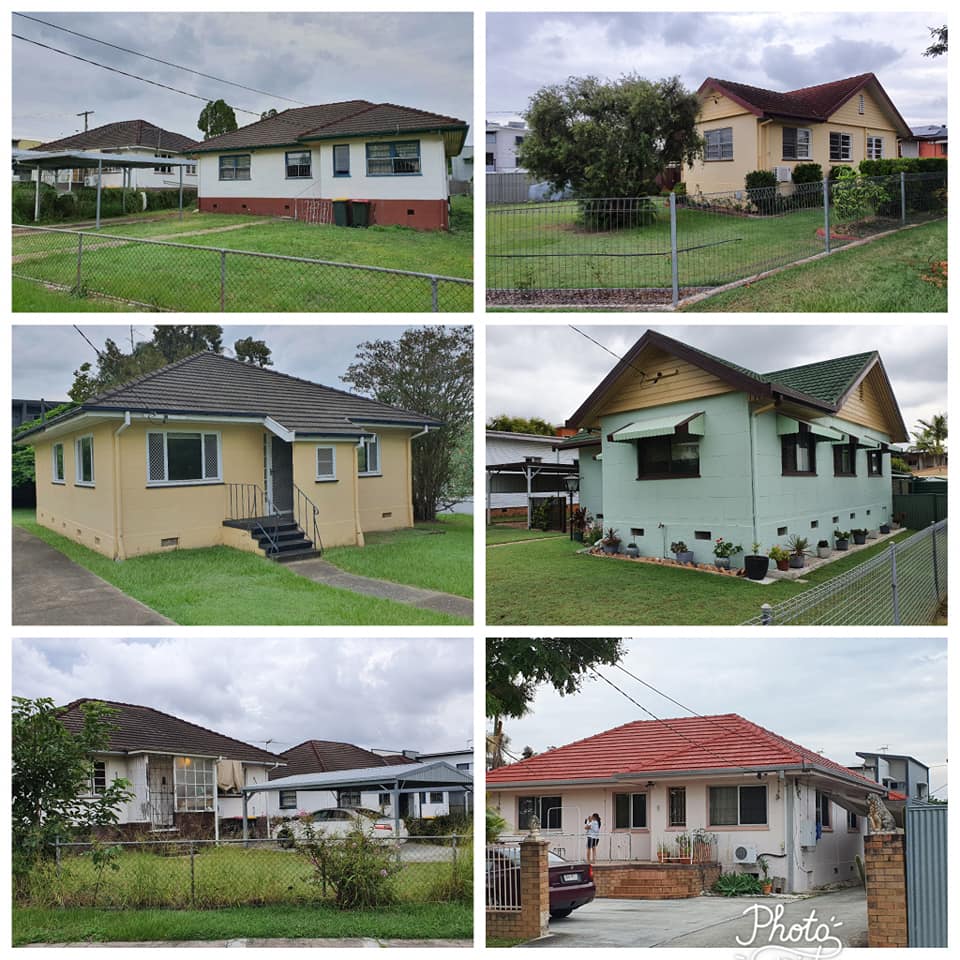
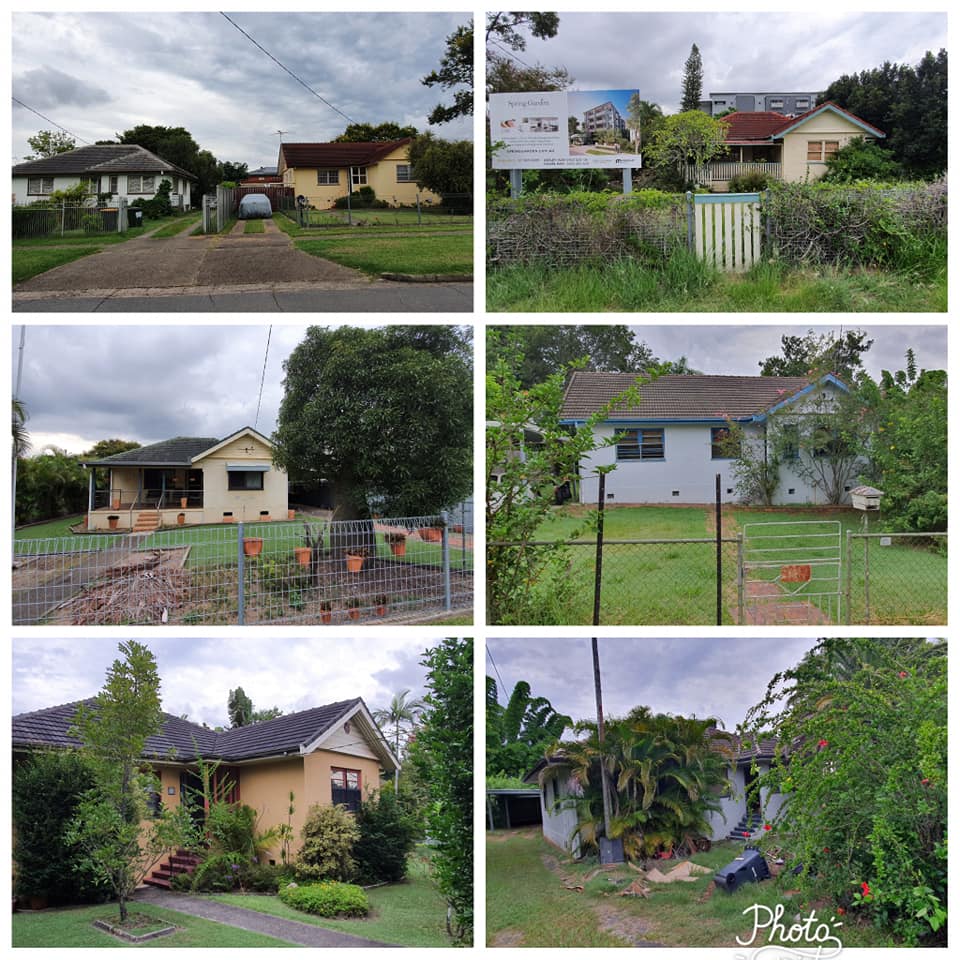
Dutch Houses still standing in 2021
Dutch Houses inventory as per 2023


